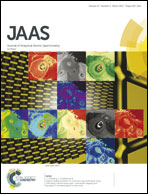High-precision isotopic analysis of Cu in blood serum via multi-collector ICP-mass spectrometry for clinical investigation: steps towards improved robustness and higher sample throughput
Abstract
High-precision isotopic analysis of Cu in blood serum via multi-collector ICP-mass spectrometry (MC-ICP-MS) has recently been shown valuable for diagnosis and prognosis of diseases affecting Cu metabolism. However, as a result of the low Cu concentration (≤2 mg L−1) in blood serum compared to the high contents of concomitant matrix elements (e.g., ∼3000 mg L−1 Na, ∼1000 mg L−1 S, ∼100 mg L−1 Ca and ∼20 mg L−1 Mg) and the measurable effect that the matrix typically exerts on the extent of instrumental mass discrimination in MC-ICP-MS, an exhaustive sample preparation protocol is required. In this work, an alternative procedure for Cu isolation from serum prior to isotope ratio measurement by MC-ICP-MS was evaluated. This procedure involves removal of the alkali and earth alkaline metals using 1 mL of Chelex-100 chelating ion exchange resin, followed by further purification of the Cu-fraction using 250 μL of AG MP1 anion exchange resin. The matrix elements were removed efficiently and Cu recoveries were quantitative in all cases. The alternative Cu isolation procedure showed several advantages compared to the conventional procedure, e.g., (i) a reduction in the amount of acids, cost and time required and (ii) lower blank levels. The effect of (remaining) concomitant matrix elements on the Cu isotope ratio accuracy and precision attainable was evaluated using both the standard interface (combination of standard cones and a large dry interface pump) and the high-transmission ‘jet’ interface (combination of ‘jet’ cones and a large dry interface pump). For standard solutions, the jet interface provided a superior internal precision (improved by a factor of 1.5) for the raw (uncorrected) 65Cu/63Cu ratio and a mitigated extent of instrumental mass discrimination. However, the influence of matrix elements on the Cu isotope ratio results was stronger with the jet interface than with the standard interface. The proposed procedure was validated using standards with known isotopic composition, a serum reference material and human serum samples. No statistical differences were obtained (at a 95% confidence interval) in the δ65Cu values using the proposed and the conventional (two column passes using 1 mL of AG MP1 resin) procedure. Finally, serum samples collected at different time points during a day from five volunteers were analysed in order to study diurnal variations in the serum Cu isotopic composition. No diurnal variations were established.

- This article is part of the themed collection: In memory of Joe Caruso


 Please wait while we load your content...
Please wait while we load your content...